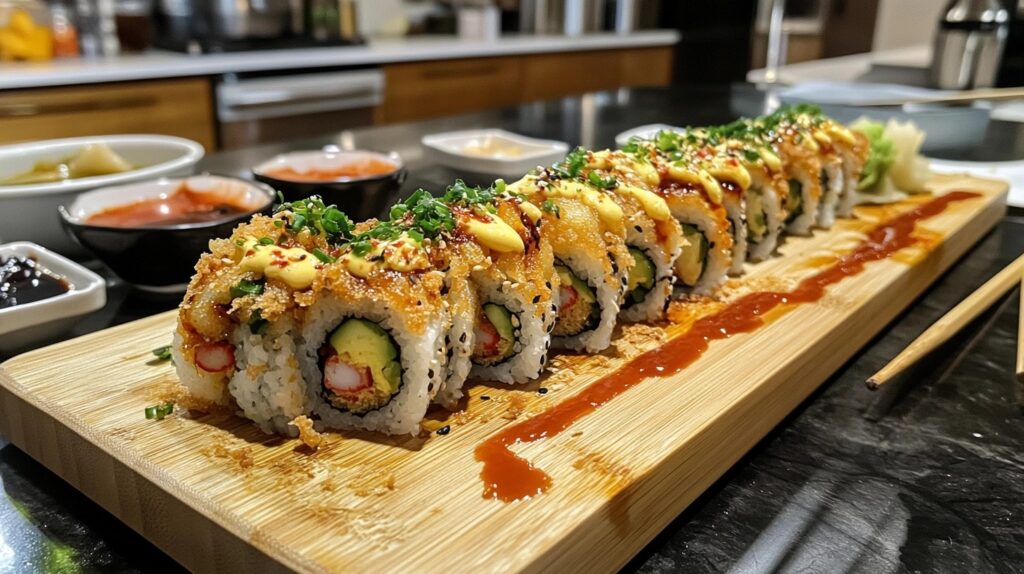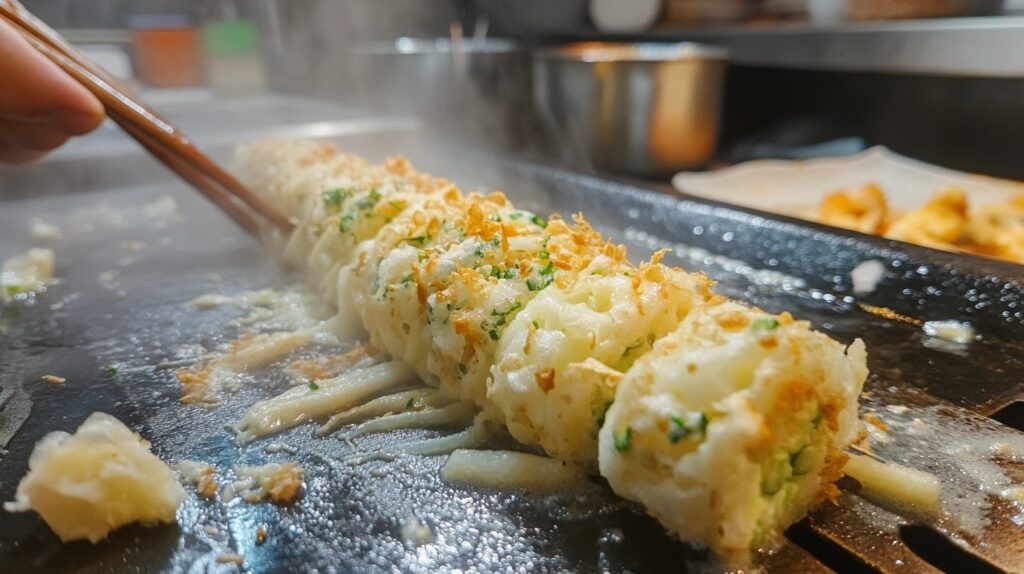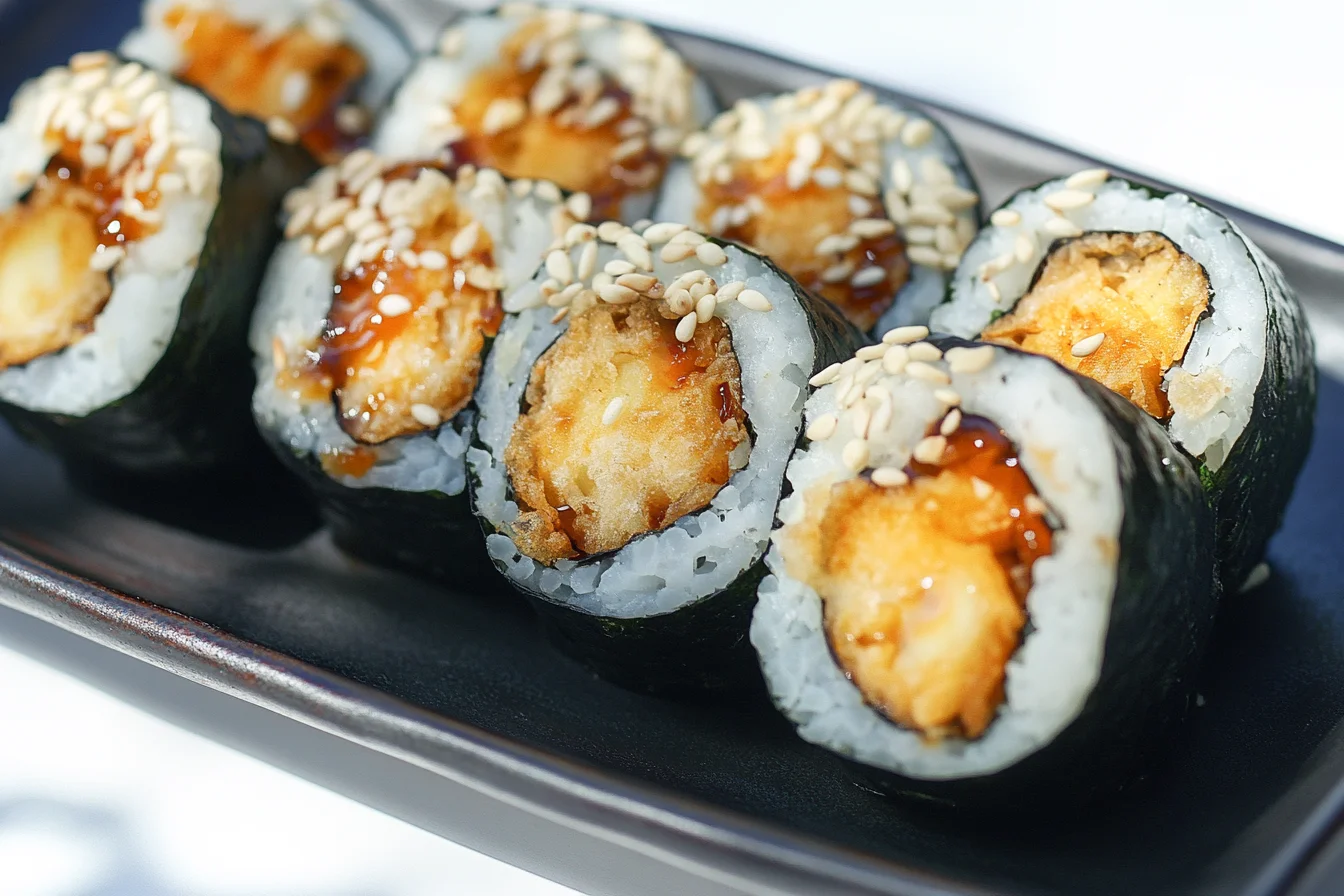Yam tempura rolls are a popular sushi choice among vegetarians and non-vegetarians alike. But is this delicious roll always vegetarian-friendly? This article dives into the specifics of yam tempura rolls, analyzing their ingredients, preparation methods, and vegetarian alternatives. Whether you’re curious about its origins, want to ensure it aligns with a vegetarian lifestyle, or are interested in making your own vegetarian yam tempura rolls, this guide covers it all.
Understanding Yam Tempura Roll
What is a Yam Tempura Roll?
A yam tempura roll is a type of sushi roll that combines tempura-fried yams with seasoned sushi rice, nori (seaweed), and optional garnishes. Its crispy texture and sweet, earthy flavor make it a favorite in Japanese cuisine. Typically served with soy sauce, pickled ginger, and wasabi, this roll offers a delightful mix of flavors.
The dish starts with slices of yam coated in a light tempura batter before being deep-fried to perfection. The crispy yam is then rolled with rice and nori, sometimes accompanied by cucumber, avocado, or other vegetables for extra crunch and creaminess.
The Origin of Yam Tempura Roll
Yam tempura rolls trace their roots to Japanese cuisine, where tempura—battered and deep-fried food—originated in the 16th century. This cooking technique was influenced by Portuguese missionaries in Japan. Over time, tempura became a staple in Japanese food culture, and chefs began incorporating tempura into sushi to create innovative rolls like the yam tempura roll.
The modern yam tempura roll is a fusion creation that gained popularity in Western sushi restaurants, appealing to vegetarians seeking tasty sushi options. While traditional sushi often includes seafood, these rolls offered a vegetarian-friendly alternative.
Analyzing Vegetarian Suitability
What Makes a Dish Vegetarian?
To determine whether a yam tempura roll is vegetarian, it’s essential to understand what constitutes vegetarian food. Vegetarian dishes avoid meat, poultry, seafood, and by-products derived from animal slaughter, such as gelatin or lard. However, dairy products, eggs, and honey are generally accepted in most vegetarian diets.
This definition matters because even plant-based dishes can contain non-vegetarian elements. For instance, animal-based broths, gelatin, or cooking oils used for frying can complicate a dish’s vegetarian status.
Is Yam Tempura Roll Always Vegetarian?
The short answer is: not always. While yam tempura rolls are often vegetarian, variations in their preparation might include non-vegetarian ingredients. Knowing the potential pitfalls is critical if you follow a vegetarian diet.
Animal Products in Tempura Batter
Traditional tempura batter typically includes flour, water, and eggs. The eggs help create a light, crispy texture when fried. If eggs are used, the yam tempura roll wouldn’t be considered vegetarian by those who avoid eggs.
Fortunately, many restaurants offer egg-free tempura batter options to cater to vegetarians and vegans. Always inquire about the batter’s composition when dining out.
Cross-Contamination Risks
Another concern is the oil used for frying. Many kitchens fry tempura in the same oil as non-vegetarian items like shrimp or chicken. While the ingredients in the yam tempura roll might be vegetarian, the shared cooking oil could introduce cross-contamination, making it unsuitable for strict vegetarians.
Restaurants committed to vegetarian customers often use separate fryers or clarify their cooking processes. It’s worth asking your server about these practices before ordering.
Why Transparency Matters
The ambiguity around the yam tempura roll’s vegetarian status highlights the importance of transparency in restaurant menus. Terms like “vegetarian” and “vegan” should be clearly defined by establishments to avoid confusion.
For those who enjoy preparing food at home, this issue can be entirely avoided. You’ll have complete control over the ingredients and cooking processes to ensure your yam tempura roll aligns with your dietary preferences.
Alternatives and Modifications
How to Make Yam Tempura Roll Vegetarian-Friendly
Creating a truly vegetarian yam tempura roll is easier than you might think, and small adjustments can make all the difference. Whether you’re cooking at home or ordering out, here are some effective ways to ensure your yam tempura roll is vegetarian-friendly.
Egg-Free Tempura Batter
The simplest change is to use an egg-free tempura batter. A mixture of all-purpose flour, cornstarch, and sparkling water works wonders for creating a light, crispy texture without the need for eggs. For even more flavor, you can season the batter with a pinch of salt, garlic powder, or paprika.
Dedicated Frying Practices
When eating out, ensure the restaurant uses a fryer dedicated to vegetarian items. This eliminates the risk of cross-contamination with meat or seafood. If that’s not an option, consider rolls that don’t require frying, like avocado or cucumber rolls.
Adding Vegetarian-Friendly Ingredients
Enhance the flavor and texture of your roll by including ingredients like avocado, cucumber, or cream cheese (if dairy is acceptable in your diet). These additions complement the crispy yam and add layers of taste to your sushi.
Vegan Yam Tempura Roll Options
For strict vegans, ensuring the roll contains no animal products is crucial. Here’s how to adapt the traditional yam tempura roll to meet vegan dietary needs.
Vegan Tempura Batter Recipe
Instead of traditional batter, a vegan-friendly mix includes flour, rice flour, and chilled sparkling water. The carbonation creates the signature light texture while keeping it animal-free. Use vegetable oil for frying to maintain its vegan status.
Skip the Nori, Try Soy Wrappers
While nori (seaweed) is usually vegan, some people dislike its taste. In that case, soy wrappers are a fantastic alternative, offering a mild flavor that complements the roll’s ingredients.
Pairing with Vegan Sauces
Swap traditional soy sauce for tamari, which is gluten-free and vegan, or add a dollop of vegan sriracha mayo for a spicy kick. These sauces elevate the flavors without compromising dietary restrictions.
Customizing for Personal Preferences
One of the best things about yam tempura rolls is their adaptability. Whether you want a spicy twist or extra crunch, you can modify the recipe to suit your tastes. Popular additions include shredded carrots, jalapeños, or sesame seeds for a nutty undertone.
With these modifications, you can enjoy a yam tempura roll that’s not only vegetarian or vegan but also tailored to your preferences.
Nutritional Perspective
Nutritional Benefits of Yam Tempura Roll
Yam tempura rolls offer a mix of nutrition and indulgence. Yams, the star ingredient, are packed with essential nutrients, including fiber, vitamins, and antioxidants. The roll also provides energy through its carbohydrate-rich rice base, making it a satisfying meal or snack.
Health Benefits of Yams
- Rich in Fiber: Yams support healthy digestion, keeping you fuller for longer.
- Vitamin C and Antioxidants: These nutrients boost your immune system and help combat oxidative stress.
- Potassium: Yams are an excellent source of potassium, promoting heart health and maintaining fluid balance in the body.
When paired with sushi rice and vegetables, the yam tempura roll creates a balanced meal with a delightful flavor profile.
Potential Concerns with Tempura Rolls
Despite their benefits, yam tempura rolls should be enjoyed in moderation due to their fried nature. Deep frying increases the calorie and fat content, which may not align with some health-conscious diets. Additionally, tempura batter often contains refined flour, which lacks significant nutritional value.
Allergens to Consider
Yam tempura rolls are generally allergen-friendly, but the batter or sauces served alongside the roll might contain gluten, soy, or eggs. If you have food allergies or intolerances, it’s vital to ask about ingredient details when ordering or to make your own rolls at home.
Nutritional Content (per 100g)
Here’s a breakdown of the nutritional composition of a standard yam tempura roll:
| Nutrient | Amount |
|---|---|
| Calories | 180 kcal |
| Protein | 2.5 g |
| Carbohydrates | 32 g |
| Fats | 5 g |
| Fiber | 2 g |
| Vitamin C | 4% DV |
| Potassium | 230 mg |
Frequently Asked Questions
Is yam tempura roll vegan?
Not always. While the core ingredient, yam, is plant-based, the tempura batter often contains eggs, making it unsuitable for vegans. Additionally, some restaurants fry tempura in shared oil with animal-based items, which may not align with vegan diets. Opt for vegan-specific rolls or ask about the preparation process when dining out.
Are sushi rolls always vegetarian?
No, most traditional sushi rolls include seafood such as fish or shellfish. However, vegetarian sushi rolls like yam tempura, avocado, or cucumber rolls have become popular alternatives. It’s essential to verify the ingredients since even vegetarian rolls might include non-vegetarian sauces or cross-contamination risks.
What is tempura batter made of?
Traditional tempura batter is a simple mix of flour, cold water, and eggs. The eggs give it a light, crispy texture when fried. For vegetarian or vegan rolls, substitutes like sparkling water or cornstarch can replace eggs while maintaining the batter’s signature crispiness.
Can yam tempura rolls contain fish?
Yam tempura rolls are generally vegetarian, but variations exist. Some restaurants may add fish roe or pair the roll with a non-vegetarian dipping sauce like fish-based soy sauce. Always check the ingredient list if you’re unsure.
How can I identify vegetarian sushi at restaurants?
To ensure you’re getting vegetarian sushi:
- Ask Specific Questions: Inquire about the batter, sauces, and cooking methods.
- Check for Labels: Many menus highlight vegetarian or vegan options.
- Request Customizations: Most sushi chefs can create a custom roll tailored to your dietary needs.
Is yam tempura roll healthy?
Yes and no. Yams are nutrient-rich and beneficial for digestion and heart health. However, the frying process increases the calorie and fat content, which may not align with every dietary plan. Enjoy yam tempura rolls as an occasional treat rather than a staple.
Practical Tips
How to Order a Vegetarian Yam Tempura Roll
Ordering a truly vegetarian yam tempura roll at a restaurant requires a little preparation and communication. While many menus offer vegetarian options, it’s still important to double-check the details. Here’s how to do it effectively:
Ask About the Batter
Many restaurants use tempura batter containing eggs. Politely ask your server whether the batter is egg-free or if they offer an alternative vegetarian option.
Confirm Frying Practices
Cross-contamination is a common concern when preparing tempura rolls. Ask if vegetarian items are fried in separate oil or if there’s any chance of shared cooking with meat or seafood. If separate fryers aren’t used, some restaurants may offer baked or fresh yam options as a substitute.
Look for Vegetarian Markings on the Menu
Many restaurants now include vegetarian or vegan icons next to their dishes. While this isn’t foolproof, it can help narrow down your choices quickly. However, always follow up with questions to be absolutely sure.
Request Customization
Most sushi chefs are happy to customize your order. If a yam tempura roll includes questionable ingredients like fish roe or animal-based sauces, ask for these to be omitted. Consider adding vegetarian-friendly ingredients like avocado or cucumber to enhance your roll.
Preparing Yam Tempura Roll at Home
If you want complete control over your yam tempura roll, preparing it at home is a fantastic option. Not only can you guarantee its vegetarian status, but you can also experiment with flavors and textures to suit your taste.

Ingredients Needed
Here’s what you’ll need to make your yam tempura roll:
- For the Tempura Yams:
- 1 medium yam, peeled and cut into thin strips
- 1 cup all-purpose flour (or gluten-free flour)
- 1/4 cup cornstarch
- 1 cup sparkling water (chilled)
- Vegetable oil for frying
- For the Sushi Roll:
- 1 cup sushi rice, cooked and seasoned with rice vinegar
- 3 sheets of nori (seaweed)
- Optional: sliced avocado, cucumber strips, or pickled vegetables
- Soy sauce or tamari for dipping
Step-by-Step Instructions
1. Prepare the Tempura Batter:
In a bowl, whisk together flour, cornstarch, and sparkling water until smooth. The batter should be slightly runny for a light coating. Keep the mixture cold by placing the bowl over a tray of ice while working.
2. Fry the Yam Strips:
Heat vegetable oil in a deep pan or fryer to 350°F (175°C). Dip each yam strip into the batter, letting excess batter drip off, and carefully lower them into the oil. Fry until golden and crispy, about 3-4 minutes. Remove and place on paper towels to drain excess oil.
3. Assemble the Sushi Roll:
Lay a sheet of nori on a bamboo sushi mat, shiny side down. Spread a thin, even layer of sushi rice over the nori, leaving a small border at the top edge. Arrange the tempura yams, along with optional fillings like avocado or cucumber, in a horizontal line across the rice.
4. Roll the Sushi:
Using the bamboo mat, tightly roll the sushi away from you, applying gentle pressure to shape it. Seal the edge with a dab of water. Repeat with the remaining nori sheets and ingredients.
5. Slice and Serve:
Use a sharp knife dipped in water to slice the roll into bite-sized pieces. Serve with soy sauce or tamari, pickled ginger, and a dab of wasabi.

Nutritional Content (Per 100g of Homemade Yam Tempura Roll)
| Nutrient | Amount |
|---|---|
| Calories | 190 kcal |
| Protein | 2.8 g |
| Carbohydrates | 34 g |
| Fats | 5 g |
| Fiber | 2.5 g |
| Sodium | 150 mg |
| Potassium | 240 mg |
Conclusion
Final Thoughts on Yam Tempura Roll as a Vegetarian Option
The yam tempura roll stands out as a beloved dish, offering a flavorful and satisfying sushi experience. However, its vegetarian status isn’t always guaranteed. Ingredients like tempura batter, cooking methods, and added toppings or sauces can introduce non-vegetarian elements, making it essential to verify details when dining out.
For those committed to a vegetarian or vegan diet, preparing yam tempura rolls at home provides full control over the process. From choosing egg-free tempura batter to using dedicated frying equipment, these adjustments ensure a delicious, plant-based sushi roll that aligns with dietary preferences.
With its crisp, sweet yam filling and customizable additions, the yam tempura roll embodies the creativity of fusion cuisine. Whether you’re savoring it at a trusted sushi restaurant or rolling it up in your own kitchen, this dish is a delightful choice for vegetarians and sushi enthusiasts alike.


2 thoughts on “Is Yam Tempura Roll Vegetarian? A Complete Guide to Ingredients and Alternatives”